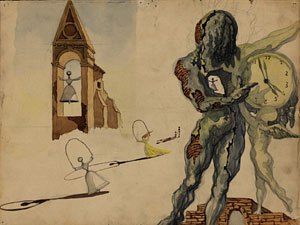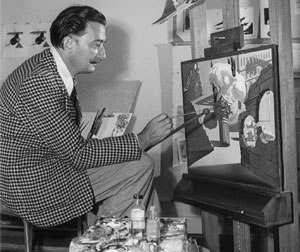Disney entrusted Hench with finding continuity among Dalis fantastical images.

If theres anyone that knows the true secrets of what went on between Salvador Dali and Walt Disney on the infamous Destino short, its John Hench, the 95-year-old Disney Legend, who somehow manages to find the strength to go to work every morning at the studio despite declining health. Best known for his assorted background, layout, color and styling work on Fantasia, Dumbo, The Three Caballeros, Alice in Wonderland and Peter Pan, not to mention his architectural designs for the theme parks and hotels, Hench was assigned to Dali by Walt as an assistant to find continuity from the basic drawings and paintings by the master surrealist. AWN recently caught up with Hench, who is as pleased as anyone about Destinos completion and acclaim after more than half a century.
Bill Desowitz: I wanted to talk to you a little bit about working with Disney and Dali on Destino and being here to see its completion.
John Hench: [Laughs] Well, I didnt do much on it again except attend meetings, but it was interesting to see the end result, which really was quite surprising to me. In spite of the bizarre images it had elegance. You know in most of Dalis great paintings, theres an element that was closely associated with him, the way he dressed and his manners. It was quite a pleasant surprise when you see the film run, and you have to see it maybe two or three times.
BD: What was your position in all of this originally?
JH: Well, they brought Dali into my room and said youll be working with him and were going to make a picture and so forth. So he came every morning on time and we spent the day together, and when I found that I had some knowledge of what he didnt seem to understand [about animation], it had to work because you cant just jump from one sequence to another.
BD: A transition.
JH: Yes, and thats what I would do.
BD: So you would help bridge all of these different segments and ideas and images that are not really connected?
JH: They are connected in a way, but you cant just do it with a cut. It would be too jarring and offer something that we never seemed to use except for a shock.
BD: Well, Dali, having worked a little bit in film before and obviously watching them, mustve had some understanding of these things you were talking about.

JH: Yes he did. He agreed.
BD: Did he find this inhibiting?
JH: No, I dont think so.
BD: He adapted to it?
JH: Yeah, he thought they were all right he approved of how we did things. Of course, I worked with him every day.
BD: Over how long a period was this?
JH: Well, I dont know, several months and then on weekends he got to spend his time in Carmel, where he had a little studio that he had rented. So my weekends usually took place there and we discussed what we had done so far, and what was coming up, so I spent a great deal of time with him. We became good friends. My faulty French was as bad his.
BD: What did you think of the original 1945 song [performed by Dora Luz]?
JH: I didnt like the music very well.
BD: What about Dali?
JH: No. But he tolerated it. He liked the title.
BD: He just tolerated the song?
JH: I think he listened to it all right. We played it all the time.
BD: Well, he must have gotten pretty sick of it huh?
JH: Well I did. But its been they improved it a great deal by adding some little height to it, and lower bass... so it improved it.
BD: More dynamic sounding?
JH: Well, it sounds more musical.

BD: So in working with him every day what were some of the highlights?
JH: Well, he came up with a kind of a scene he wanted to introduce, a quality to or a meaning, and that was fine. We worked on that. He was pretty good at choosing angles and choosing any action, and then that would trigger another idea and he would jump onto that. So I ended up making more drawings than he did. He made the principal scene; he designed that one introduced something and then it would have to [complement] one we had already made. And he would do them over again, but he was pretty careful about keeping a continuity. That is, different stages that were radically different in their meaning and in their appearance. And it was up to me to ease those in from one to another without the idea of just a cut and you didnt know where you were. It was a job I liked.
BD: And he seemed to enjoy it as well?
JH: Yeah, he seemed to have a fun too. And then there were little things on the side that happened and, oh, like where he had a very large Ive forgotten what kids play with it usually has broken glass in one end and three mirrors. You know that toy?
BD: A kaleidoscope?
JH: Yeah, a kaleidoscope. And we had a large one that we had made and we made it together and he would turn a landscape into a kaleidoscopic landscape. It was really astonishing. And we used this for a while and we found something good we could use.
BD: Did it manage to find its way into the short?
JH: No, we didnt find a place to use it, but it was something that was very interesting. And we researched quite a bit of Raphael. Thats a favorite artist of his.
BD: What were some of your favorite sequences?

JH: I thought Id shoot this one scene because I thought it was so astonishing. It was an appearance of the female character, the ballerina, and it was an empty field with just a white ball floating on a field and then two turtles, one approaching from the left and then the right, and I used sliding fills because I didnt have an animator that I could use. But we pulled these slides across and then when they met, the negative space turned into the ballerina and the ball was her head. And I thought, yeah, I can show that to Walt. He may just go ahead with the thing anyway.
BD: So this was the 15-second sample that survived?
JH: But it was very surprising and I thought it would interest him. And it did interest him too but he put it aside, though. Years afterward, whenever Walt and I talked about Dali, he always said we should have made that thing anyway.
BD: What were your meetings like with Walt and Dali?
JH: Well, in our meetings we discussed the idea of one form morphing into another and when it was right, quit tearing it up so that it remained a double form.
BD: What was their interaction like? Was it hard for them to communicate?
JH: No. No, I think that a term like morphing and they understood that and what it could lead to and I interpreted some of the meanings of things, which they wouldnt know. For instance, the hummingbird represented poetry because the hummingbird takes only the essence of the flower and Dali claimed that poetry takes the essence of the idea and things like that had to be explained.
BD: Do you remember any specific ideas that Walt introduced?
JH: Well, they had a Roman god and, uh, it represented a blockage to a labyrinth, but the hummingbird opened it and it became a passageway. I dont know if people got that or not.

BD: So that was his idea?
JH: Yes.
BD: So you were pretty much on the same wavelength in using very abstract imagery here?
JH: Oh, yes, everything had some meaning and most of it was to the story of the destiny of love. They kept it pretty much to the theme, only I think the way the morphing was done when one animates to another was very skillful. You were conscious of a flow.
BD: I understand the baseball sequence was very difficult.
JH: Well, yes, because it became a ballet.
BD: Only a fragment of that survives in the finished film.
JH: Well, thats all that seemed to be needed. Though it was kind of an original idea treating baseball as ballet. Which it is when you think of it.
BD: What involvement did you have when they decided to finish this?
JH: Well, outside of meetings about what certain things stood for, you know, what they meant to Dali, that was it. I didnt make any more drawings.

BD: Were there any other things that cropped up that needed explaining?
JH: Well, part of it was the girl where she finds her way and the towers and the falling hair we had it a little more elaborate on the original storyboard, but they dealt with that very neatly. And the tower is the morphing, I think particularly good for that.
BD: What was it like watching the finished film?
JH: Well, I had to see it three times. It evolved so rapidly.
BD: Yeah, it is a lot to absorb.
JH: But the second time around is better and the third time around is even better.
BD: Aside from the elegance that obviously comes through, what else?
JH: With my experience with Dali, I knew the images pretty well and, of course, it was great to see the actual movement instead of just a bunch of stills. The storyboard is very limited.
BD: And did you think that captured the essence of it?
JH: Yes, I did.
BD: And what about the limited but effective use of 3D computer animation for some of the modeling and camera movement?
JH: It was entirely adequate. I dont know what parts were computer, but they understand exactly how much they can use of it, of course. I thought the color was quite satisfactory that I remembered.
BD: Did you make any contact at all with Dali after it was over?
JH: Oh, yeah. There were some little things he wanted done for him and I did those. On my own time. Not regarding the picture; it was regarding a painting he was doing.
BD: Did he discuss animation in general? Did you have conversations about the nature of animation and how you made things there at Disney?
JH: Not very much, no. When I thought something was necessary, then Id have to explain it. He was open about movement, he understood that things were going to move and youre going to watch the changes that took place. And you rely on a certain situation. He painted often. Detailed pretty well, pretty thoroughly so he would arrive at that with just a simple cut.
BD: So overall youre pleased with Destino?
JH: I think it was a really surprising thing, and I dont think well ever see another thing like it. I do think that the surprising thing was the elegance that came through, though the turtles seem to suggest that because they were highly decorated. They suggested elegance.
BD: Well, its interesting that Dali talked about the complexity of it and that he didnt want it to be fully explained away, and that Walt seemed to reduce it to the essence of a love story. But the two of them really were more in synch with the deeper complexities of the imagery. It wasnt a matter of one having a more complex interpretation than the other.
JH: No, I think they agreed on it.
Bill Desowitz is the editor of VFXWorld.







